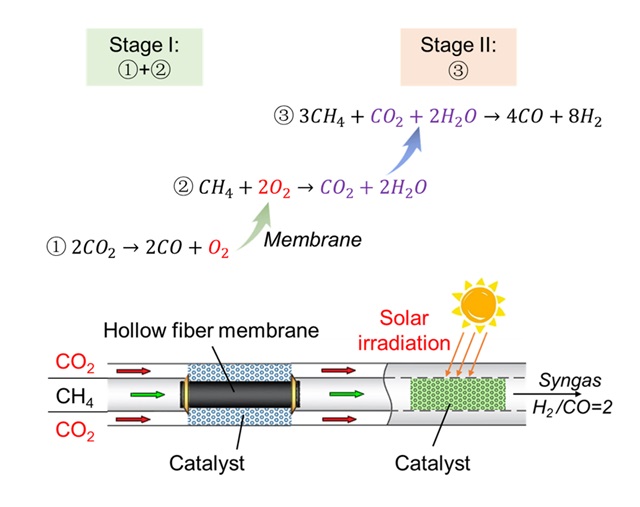Solar-assisted two-stage catalytic membrane reactor for CO₂ splitting
Published 12 October, 2024
As major greenhouse gases, CO2 and CH4 are the primary drivers of climate change. Hence, utilizing CO2 and CH4 as feedstocks for the synthesis of value-added chemicals offers significant economic and environmental benefits. However, the principal challenges associated with converting these two molecules pertain to their kinetic stability and thermodynamic equilibrium limitation.
Catalytic membrane reactors based on the oxygen-permeable perovskite membranes can realize the bi-functions of oxygen separation and heterogeneous catalytic reactions in a single unit, thereby enabling simultaneous conversion of CO2 and CH4 and offering superior advantages over conventional fixed-bed reactors. Nonetheless, there remain issues such as the discrepancy between the catalytic reaction rate and the O2 separation rate, the low single-pass CO2 conversion (less than 30%), and the substantial energy input requirement.
To that end, Wanqin Jin and his co-workers from Nanjing Tech University designed a unique two-stage catalytic membrane reactor that employs an asymmetric oxygen-permeable membrane and solar irradiation for CO2 splitting (2CO2→2CO+O2) and CH4 oxidation to syngas.
“In our designed catalytic membrane reactor, the oxygen generated from the CO2 splitting reaction can be extracted through the oxygen-permeable membrane with 100% selectivity, and subsequently employed for solar-assisted methane combustion and reforming,” shares Guangru Zhang, co-corresponding author of the study published in the KeAi journal Green Energy & Environment. “The solar-assisted catalytic membrane reactor achieves a prominent CO2 conversion of 35.4% and H2 yield of 18.1 Ml min-1 cm-2 which is 62- and 1.5-times higher than that of a fixed-bed reactor and a catalytic membrane reactor without solar irradiation, respectively.”
Notably, the design of the two-stage catalytic membrane reactor also provides excellent flexibility for selecting membrane configurations including disk- and hollow fiber-shaped membrane. This design is expected to realize the coupling of diverse chemical reactions or processes on both sides of hollow fiber membrane with different operating temperatures and pressures.
“Our work provides an innovative strategy for reducing CO2 emissions, with the potential to mitigate the carbon footprint across industrial sectors.” Adds another senior and corresponding author Wanqin Jin.

Contact author details:
Wanqin Jin, State Key Laboratory of Materials-Oriented Chemical Engineering, College of Chemical Engineering, Nanjing Tech University, 30 Puzhu Road(S), Nanjing 211816, P.R. China, wqjin@njtech.edu.cn.
Guangru Zhang, State Key Laboratory of Materials-Oriented Chemical Engineering, College of Chemical Engineering, Nanjing Tech University, 30 Puzhu Road(S), Nanjing 211816, P.R. China, guangru.zhang@njtech.edu.cn.
Funder: This work was supported by the National Key Research and Development Program of China (2022YFE0101600), the National Natural Science Foundation of China (U23A20117), the Natural Science Foundation of Jiangsu Province (BK20220002, BE2022024) and the Leading Talents Program of Zhejiang Province (2024C03223) and Topnotch Academic Programs Project of Jiangsu Higher Education Institutions (TAPP).
Conflict of interest: The authors declare that they have no known competing financial interests or personal relationships that could have appeared to influence the work reported in this paper.
See the article: Jinkun Tan, et al., Solar-assisted two-stage catalytic membrane reactor for coupling CO2 splitting with methane oxidation reaction, Green Energy & Environment,